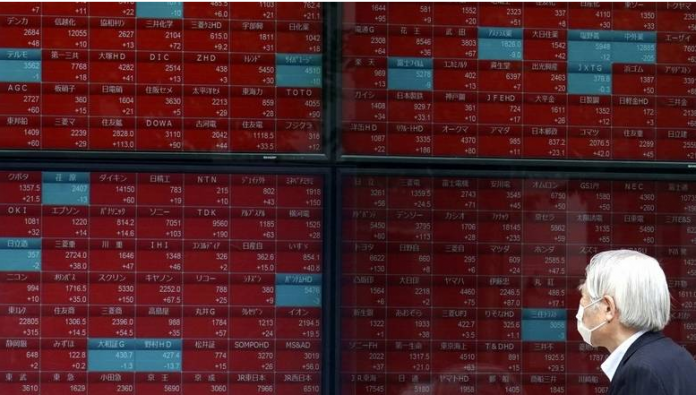Asian stock markets are higher after Wall Street advanced as investors looked past dismal US jobs and other data toward hopes for a global recovery from the coronavirus pandemic.
Asian shares followed Wall Street higher on Monday as investors looked ahead to more countries restarting their economies, even as some reported an unwelcome pick up in new coronavirus cases.
European markets are also heading north, with EUROSTOXX 50 futures and FTSE futures up about 1per cent. E-Mini futures for the S&P 500 opened softer but bounced as the Asia day wore on and was last up 0.5 per cent.
Encouraging investors in Asia was further loosening of coronavirus restrictions in the region with New Zealand easing some curbs from Thursday while Japan plans to end a state of emergency for areas where infections have stabilised.
In Europe, millions of French people are also set to cautiously emerge from one of that region’s strictest lockdowns on Monday.
That comes even as South Korea warned of a second wave of the new coronavirus as infections rebounded to a one-month high, while new infections accelerated in Germany.
Investors seemed determined to stay optimistic and MSCI’s broadest index of Asia-Pacific shares outside Japan firmed 1.1 per cent.
Japan’s Nikkei climbed 1.5 per cent to 20,485.00 points in afternoon trade. Earlier in the session, the index rose as much as 1.8per cent to hit its highest since March 6.
Chinese blue chips rose 0.1 per cent. Chinese inflation and production data due this week will be closely watched for clues on how the pandemic has hit demand in the world’s second-largest economy.
Wall Street had rallied on Friday after the April payrolls report proved dire but not quite as awful as analysts’ worst fears. “Just getting the worst jobs report in history out, is at the margins helpful for risky assets,” said Alan Ruskin, head of G10 FX at Deutsche Bank.
“Since late March there has been an extraordinary divergence between the real economy and financial risk, with the latter helped by unprecedented policy accommodation,” he added.
“Markets know the real economy data is awful. We are less sure of how long markets aided by policy, can defy the real economy, if the growth improvement is slow.”
The bond market certainly seems to think any recovery will be slow with two-year yields hitting record lows at 0.105 per cent and Fed fund futures turning negative for the first time ever.
The rally in prices has come even as the US Treasury plans to borrow trillions of dollars in the next few months to plug a gaping budget deficit.
Federal Reserve Chair Jerome Powell is due to give a keynote speech on Wednesday and analysts suspect he will rule out taking rates negative, at least for now.
The decline in US yields might have been a burden for the dollar but with rates everywhere near or less than zero, major currencies have been stuck in tight ranges.
The dollar was a shade firmer on the yen at 106.94 on Monday but well within the 105.97 to 109.37 band that has lasted since late March. The euro was a fraction softer at $1.0848 but above last week’s low at $1.0765.
Against a basket of currencies, the dollar was idling at 99.701, sandwiched between support at 98.769 and resistance around 100.40.
In commodity markets, gold edged up 0.32 per cent to $1,706 an ounce.
Oil prices opened about 1per cent lower as a persistent glut weighed on prices and the coronavirus pandemic eroded global oil demand, even as some governments began to ease lockdowns.Brent crude futures lost 22 cents to $30.75 a barrel, while US crude fell 15 cents to $24.59.



